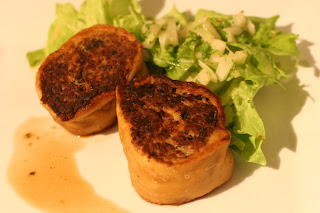French and Belgian people are always kidding each other, but they really like each other, maybe just like kiwis and Aussies (?) ... Well, humour is just a way to show affection, isn't it?
 |
| Grand Place of Bruxelles, Belgium (Pic from here) |
Anyway, to avoid some huge debate about the origin of the dish that I am going to introduce to you today, let's say that Northern France and Belgium share at least one famous dish: the Carbonnade Flamande. This is a beef casserole cooked in a beer sauce that is lovely with fries and a pinte of beer, of course! A very easy but tasty dish to make for family or friend events!
 |
| Grand Place of Lille, France (pic from here) |
Ingredients (6 servings):1,5kg beef, e.g., blade steack, gravy beef, chunk beef (you can even mix various cuts of the beef)
5-6 onions
40g of butter
3/4 cup of soft brown sugar
3/4 cup of flour
1 liter of blonde beer, e.g., leffe (the better the beer is, the better the dish will be)
6 slices of ginger bread (pain d'épice)
French mustard of Dijon
salt, pepper, baie leaves, thyme
Preparation time: 20 min
Cooking time: 2h30 (the longer it cooks, the better it is!)
 Method:
Method:
Cut the beef into cubes (4 cm).
Slice the onions.
Heat the butter into a large pot and fry the beef briefly on each side. Then take the meat out of the pot and rest it.
Fry the onions into the rest of the butter. When gold, add the soft brown sugar and caramelize a little bit. Then stir the flour in and pour the beer gradually. Do not stop stiring to get a smooth sauce.
Slow down the heat and add the meat, salt, pepper and herbs. Stir and let cook on a very low heat for 45 minutes.
Spread the mustard onto the slices of ginger bread and put them on the top of your casserole after the first 45 minutes, and let cook for 90 minutes, at least. Sti occasionnally, when the slices of ginger bread will be wet enough, they will dissolve into the sauve, giving it a great flavour.
Remember, the longer you let the casserole stew, the smoothest the meat will be. It's even better when reheated the next day.
Serve with french fries or pasta. Enjoy this very friendly dish with the same beer you used for the sauce or with a red wine!
 |
| Sorry for this awfull picture! I have messed up my photos ;-) |
|
I'll download a new one the next time I do this recipe!
Click here to see nice pictures of the Carbonnade Flamande.

 After 2 hours, roll out the noodle dough very thin and spread the stuffing on. Then roll it and slice it (3 to 4 cm wide).
After 2 hours, roll out the noodle dough very thin and spread the stuffing on. Then roll it and slice it (3 to 4 cm wide).














































